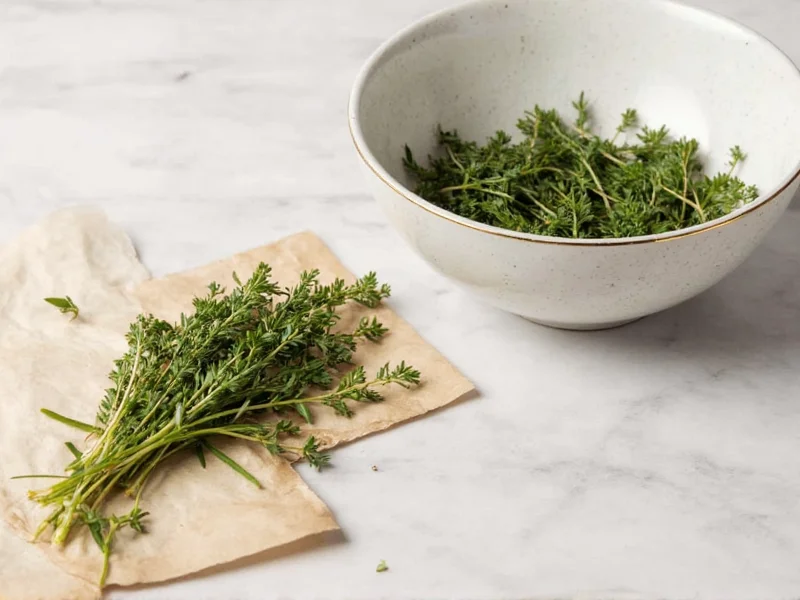Cutting fresh thyme properly makes a significant difference in both flavor preservation and culinary presentation. Whether you're preparing a simple weeknight dinner or an elaborate feast, knowing how to properly trim fresh thyme ensures you maximize this aromatic herb's potential without wasting precious leaves.
Essential Tools for Cutting Fresh Thyme
Before learning the best way to chop fresh thyme for cooking, gather these basic kitchen tools:
- Sharp chef's knife (a dull knife crushes rather than cuts)
- Cutting board (wood or plastic works best)
- Small bowl for collecting trimmed leaves
- Clean kitchen towel or paper towels
- Optional: Herb stripper tool for frequent thyme users
Step-by-Step: How to Cut Fresh Thyme Properly
Step 1: Prepare Your Thyme
Rinse thyme sprigs under cool running water to remove any dirt or debris. Gently shake off excess water, then pat completely dry with a clean kitchen towel. Never cut wet thyme as moisture dilutes essential oils and causes leaves to slip during cutting.
Step 2: Remove Leaves from Stems
There are two primary methods for how to remove thyme leaves from stem:
Method A: Pinch and Strip (Recommended)
Hold the top 1-2 inches of the thyme stem firmly between your thumb and forefinger. Place your other hand's thumb and forefinger at the bottom of the stem. Slide your fingers upward toward the held portion, stripping the leaves off the woody stem in one smooth motion. The small, tender leaves will collect in your hand while the tough stems remain.
Method B: Knife Technique
Lay several thyme sprigs together on your cutting board. Place the flat side of your knife blade perpendicular to the stems near the leafy top. Press down firmly while sliding the knife toward the woody end, scraping the leaves off the stems. This method works well for larger quantities but requires more precision.
| Method | Best For | Flavor Preservation | Speed |
|---|---|---|---|
| Pinch and Strip | Small quantities, delicate dishes | ★★★★★ | ★★★☆☆ |
| Knife Technique | Larger quantities, robust dishes | ★★★☆☆ | ★★★★☆ |
| Herb Stripper Tool | Very large quantities | ★★★☆☆ | ★★★★★ |
Step 3: Chop Thyme Leaves (If Needed)
For recipes requiring finely chopped thyme:
- Gather stripped leaves into a small pile on your cutting board
- Use a sharp chef's knife with a rocking motion to mince leaves
- Cut just until desired consistency is reached - over-chopping releases bitter compounds
- For maximum flavor, sprinkle a pinch of coarse salt over leaves before chopping to help break down cell walls gently
Pro Tips for Cutting Fresh Thyme
- Avoid bruising: Thyme leaves contain delicate essential oils that degrade when crushed. Always use a sharp knife and minimal pressure.
- Work quickly: Exposure to air causes flavor compounds to dissipate. Prepare thyme just before use.
- Use the right portion: Only the tender top 3-4 inches of thyme sprigs contain usable leaves. Woody lower stems should be discarded.
- Never use scissors: Scissors crush rather than cut thyme, releasing enzymes that create bitter flavors.
Common Mistakes When Cutting Fresh Thyme
Even experienced cooks make these errors when handling fresh thyme:
- Using wet thyme: Moisture prevents proper adhesion during the pinch-and-strip method and dilutes flavor
- Cutting too far down the stem: The lower portion is woody and inedible - focus on the top leafy section
- Over-chopping: Excessive cutting releases bitter compounds from damaged cells
- Using a dull knife: Crushes rather than cuts, damaging essential oil pockets
Storing Cut Fresh Thyme
If you've prepared more thyme than needed for your recipe:
- Place chopped thyme in a small airtight container with a slightly damp paper towel
- Store in the refrigerator for up to 3 days (flavor diminishes quickly after cutting)
- For longer storage, freeze thyme leaves in olive oil in ice cube trays
- Never store cut thyme in water - this accelerates spoilage
When to Use Whole Sprigs vs. Cut Thyme
Understanding fresh thyme preparation techniques includes knowing when to use whole sprigs:
- Use whole sprigs for soups, stews, and braises (remove before serving)
- Use stripped leaves for salads, dressings, and dishes where texture matters
- Use finely chopped thyme for rubs, compound butters, and delicate sauces
FAQ: Fresh Thyme Cutting Questions
Can I use scissors to cut fresh thyme?
No, scissors crush thyme leaves rather than cutting them cleanly, which damages the essential oil pockets and creates bitter flavors. Always use a sharp chef's knife for proper cutting fresh thyme without bruising.
How far down the stem should I cut fresh thyme?
Focus on the top 3-4 inches of the thyme sprig where the leaves are tender. The lower portion becomes woody and inedible. When using the pinch-and-strip method for how to remove thyme leaves from stem, you'll naturally stop where the stem becomes too tough.
Why does my thyme turn bitter when I cut it?
Bitterness occurs when thyme leaves are over-handled or crushed rather than cut cleanly. This releases enzymes that create bitter compounds. Use a sharp knife, work quickly, and avoid excessive chopping to maintain the herb's delicate flavor profile.
How long does cut fresh thyme stay fresh?
Cut fresh thyme begins losing flavor immediately. For best results, use within 1-2 hours of preparation. If necessary, store in an airtight container with a slightly damp paper towel in the refrigerator for up to 3 days, though flavor will diminish significantly.
Can I freeze fresh thyme without cutting it?
Yes, freezing whole thyme sprigs preserves flavor better than freezing cut leaves. Simply place dry sprigs in a freezer bag, removing as much air as possible. When needed, crumble frozen leaves directly into your dish - no need to thaw first. This method works well for fresh thyme preparation techniques in cooked dishes.











 浙公网安备
33010002000092号
浙公网安备
33010002000092号 浙B2-20120091-4
浙B2-20120091-4